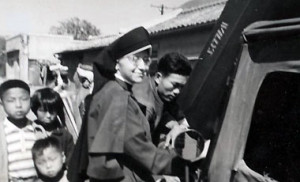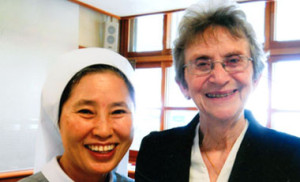I became acutely aware of the need for more anesthesia providers in Korea as I was working at Maryknoll Hospital in Busan (previously Pusan). In many small hospitals, the medical doctor first gave the anesthetic, then operated, with no one watching the patient. This led to many unnecessary deaths which affected me deeply. Soon a kernel of an idea was beginning to take form–why not extend myself by teaching others to do anesthesia.
This is what I did. In 1970, with the support of our hospital administrator, the first class of nurses began. These men and women are still active in anesthesia, and have done exemplary work in the field over the years. I am so proud of them. As the students completed their study, they easily found placements in local hospitals which recognized their excellence in administering safe “watchful care” anesthesia.

The next step was to have the program recognized as a certified program with the National Ministry in Korea. By the late 1970s, the program received approval as a certified program for nurse anesthetists, recognized by the Ministry of Health and Social Affairs. This was a moment of sheer joy for us all. I realized, in implementing the above and know now for sure, that it could not have accomplished this without the support, dedication and enthusiasm of the courageous men and women whom I had taught over the years.
As I reflect on those early years of our growth, what was so quickly noticeable was: initiating the NA program was a response to a real, felt need in Korean society in the field of anesthesia. The development of the KANA responded to a need for stability and organization: united together, we could effectively face the obstacles in our professional development and delivery of anesthesia. The KANA succeeded because of its devoted and committed members. In the formative years we received much support and assistance from members of the American Association of Nurse Anesthetists (AANA), namely John Garde, Ron Caulk and Sandra Maree Ouellette, who came to Korea as guest speakers several times at our annual meetings. We coordinated our meetings with those of the AANA and the IFNA, of which Korea is one of the Charter members.
In September 2014, I was pleased, honored and humbled to accept the prestigious Hermi Lohnert Award–and very special thanks to the International Federation of Nurse Anesthetists (IFNA) board for selecting me, to the AANA for arranging this ceremony (held in Orlando, FL, on September 13, 2014), and to those who nominated me and supported my nomination. Also an enormous salute to Marianne Reisen of Switzerland, the other nominee for this year’s award. And thank you to my friends and colleagues in the field who have inspired me nationally and internationally, to ensure the relevance of nurse anesthesia in this changing world.
Lastly, I feel this award could rightly be given to the nurse anesthetists of Korea, for without them, nothing would have been developed over the years. I had the kernel of the idea, they were the leaven which made it increase and expand beyond our dreams or expectations! Over the years, I watched the development of the nurse anesthetists in Korea, and the advancements they have made personally and professionally in so many ways. The people of Korea have been beneficiaries of excellent anesthesia care, and I realize how fortunate I am to leave this legacy to the nurse anesthetists of Korea, confident that they will continue to initiate timely advances in promoting the continued success of the profession on the Korean peninsula.
In closing, our Maryknoll Sisters foundress, Mary Josephine Rogers, left us a great legacy, and much wisdom. I quote her here, for it also applies to the work in Korea:
“There is nothing more astonishing than life, just as it is,
Nothing more miraculous than growth and change and development,
Just as revealed to us.
And as happens so often when we stop to regard God’s work,
There is nothing to do but wonder and thank God,
Realizing how little we planned,
And yet how much has been done.”
–Mother Mary Josephine Rogers, MM (1936)
I am extremely grateful for having been in anesthesia and having been assigned to Korea, where my life blossomed thanks to God’s grace and the many wonderful, faithful, creative and talented people with whom I met over the years. Thank you.

